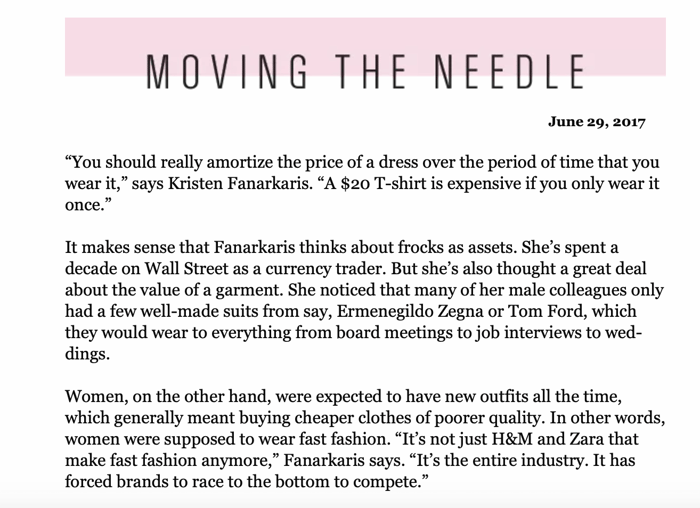So much talk, so little progress. Since I launched Senza Tempo, the conversation around how to shop more sustainably went from niche to mainstream. Two different comments on two different social media platforms recently reminded me of the first press feature I received for Senza Tempo back in 2017. Fast Company's Liz Segran introduced Senza Tempo in her newsletter, Moving the Needle, where she highlighted my approach to "Amortize Your Wardrobe." Unfortunately, the needle has barely moved when it comes to the idea of amortizing your wardrobe as a way to shop more sustainably, while fashion increased its environmental footprint in terms of volume and emissions. Shopping more sustainably is a mindset — it's how you use what you buy which requires being thoughtful about what you buy.
I’ve pitched countless variations of this idea to reporters over the years, written blog posts, and created more social media posts than I ever want to count or think about. But tech pipe dreams continue to dominate the weekly sustainable fashion headlines alongside a litany of eco-adjectives from preferred materials to the latest certification. Brand-owned resale joined the buzzword bandwagon over the past year to the tune of a 244% increase in brand-owned resale in 2022 compared to 2021 according to the latest Thred-Up report. Most advice on how to shop more sustainably continues to focus on the adjectives attached to a product or brand. The narrative never covers how to get more USE out of what you buy. It's all B-corps and buzzwords. If you want to shop more sustainably, you need to think about amortizing the cost and thereby the environmental impact of each item.
Every time you wear a garment, you lower the cost per wear and the initial environmental impact. Both the cost and impact are amortized with USE like a mortgage — diminishing over time. The longer life an item can have in your wardrobe, the more you can reduce the cost per wear. Here's a Google Sheet to help you calculate the cost per wear of any item you buy or already own feel free to save a copy and change the time parameters to suit how you wear what you buy.
You'll naturally gravitate to higher-quality, long-lived items when you shop with amortization in mind.
Never forget that quality does not necessarily mean buying luxury items. It's important to understand what makes something a better quality product. Again, shopping sustainably is more about actions, not adjectives, unregulated certifications, or logos. Think about what kind of items you always go back to before you buy and how an item will fit within your wider wardrobe. I always go back to black skirts, black dresses, white shirts and navy casual wear.
No certification or even fashion rating system includes USE as a factor. Buying an organic cotton dress with a QR code loaded with information, controlled by the brand mind you, isn’t very 'green' if you only wear it once or twice and then ship it out to be re-sold — which only adds to the original carbon footprint from production (a nuance left out of the entire resale conversation).
Senza Tempo's philosophy and the idea of amortizing your wardrobe is not new or revolutionary, it’s how people shopped for decades: for longevity and maximum use. Sustainable shopping has nothing to do with adjectives attached to what you buy, but how and how long you use what you buy. It’s about actions, not adjectives.
With the EU cracking down on green claims and the FTC re-evaluating the Green Guides, it will be interesting to see how the narrative over the next six years shapes up.
Here’s a sample of posts related to amortizing your wardrobe. I post nuggets on social media regularly that always come back to the following ideas: shop as local as possible (this goes for food and any consumer good), simply find ways to get the most out of everything you buy — that's how to be a more sustainable shopper.
Focus on Rewear Repair and Reuse Instead of Resale or Recycling to be More Sustainable
Sustainable Fashion Myths & What Makes Fashion Transparent
A Royal Wardrobe: King Charles — Sustainable Style Icon?
How to Clean Out Your Closet in Four Easy Steps
Grace Kelly — Thrifty Style Icon?
American Fashion Behind the Seams — How Our Clothing Is Made
Carefully Edited Collections: The Key to Sustainable Fashion
The Benefits of Using Silk in Clothing
A New Look at Sustainable Fashion


